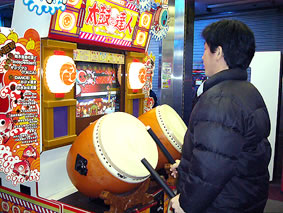
Here a person swings a baseball bat, over there another shoots a soccer ball, and still others beat Japanese drums or dance to music. They're all soaking with sweat, and they're all in the same space. Where is this?
The answer is a video arcade. These people are playing video games, but their bats, soccer balls, and drums are all life-size. Action simulation games like these, in which the player moves around in time with the images on the screen or with music, are getting popular in Japan.
About three years ago, music video games became the rage at arcades across Japan. In these games, players follow the indicators on the screen, such as by dancing or by playing on the keyboard, while keeping rhythm to music. Arcades became crowded with people wanting to play music games. Not just the usual arcade goers but also women and families with young children - who in the past tended to stay away from arcades - could be seen playing these games.
Following the boom in music video games, action simulation games have become quite diversified. In many larger arcades nowadays, action simulation games take up a considerable amount of floor space, overshadowing conventional games in which players just sit and press the control buttons. Sports-type games include everything from baseball, table tennis, and soccer to boxing and snowboarding. There are many other unique offerings: a sword-fighting game in which the player combats enemies in the screen using a sword-shaped controller; a martial arts action game that is good for keeping fit and for slimming down; a shooting game in which the player pursues gangsters as a police officer, at times crouching for cover; a fishing game; a dog walking game; a photographer game; and so forth. In addition, one of the games that are scheduled to appear in arcades in the near future is a voice-acting game using footage from famous animated cartoons.
Action simulation games have made their way into the home as well, mainly as software for video game consoles like PlayStation 2. Among the first action simulation games for personal use was Excite Stadium, released by the toymaker Epoch Co. (site is Japanese only) in 2000. Excite Stadium is a preprogrammed game machine that is hooked up to the television. It comes with a bat-shaped controller, which the player swings to "hit" the balls thrown by the pitcher on the screen. The controller is covered with sponge, inside of which there is a sensor that detects the movement of the bat and sends infrared signals containing this data to the main unit. In this way, the player's action is reflected in the movement of the ball inside the screen. There are several game modes, including a regular baseball match and a home run derby.
Excite Stadium became a big hit, particularly because it only requires users to hook up the machine directly to the TV, with no need for expensive game consoles. Triggered by this success, many other action simulation games for the home have come out since then. For instance, a PlayStation 2 version of the Japanese drumming game mentioned in the introduction, called Taiko no Tatsujin ("Drum Master"), came out in October 2002 and is in high demand. The game package consists of software and a controller set in the shape of a drum and drumsticks.
Action simulation games are popular not only among children but among adults as well. "It's good exercise, and my mom says it's a great stress reliever, so we play the dance game together," says one girl. A boy who likes playing sports games comments, "I always play against my dad, but I'm much better than him." The fact that everyone in the family can enjoy these games together appears to be a key factor in their popularity.
Photo: A player on the Taiko no Tatsujin game beats an object shaped just like a real Japanese drum.
|

